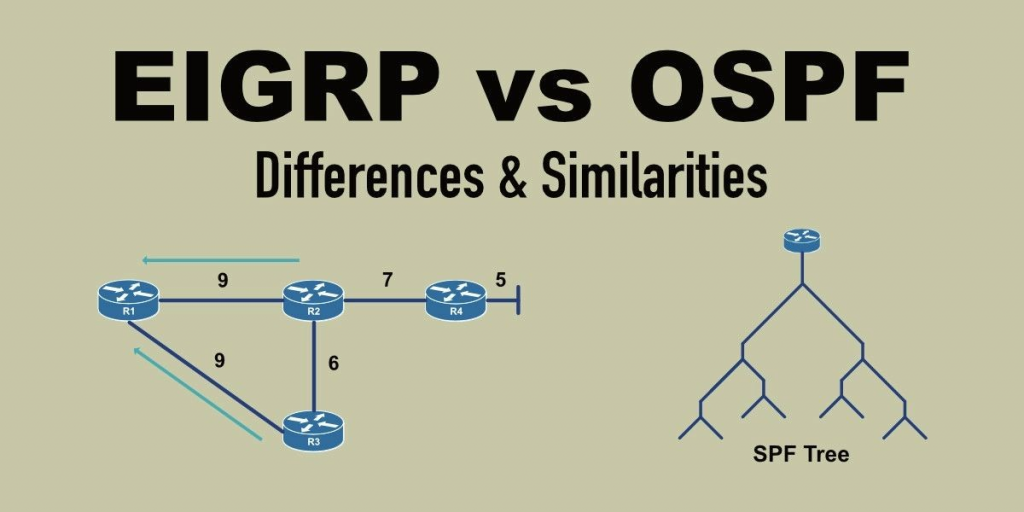Selecting the right dynamic routing protocol is a core architectural decision for your enterprise network. While both OSPF and EIGRP are widely used Interior Gateway Protocols (IGPs), their design philosophies, operational behaviors, and scalability considerations differ significantly.
This deep dive will help you understand when to choose OSPF vs EIGRP, how each protocol operates, and practical deployment considerations to build resilient, scalable, and efficient networks.
1. What Are OSPF and EIGRP?
OSPF (Open Shortest Path First) is a link-state routing protocol standardized by IETF. It uses Dijkstra’s SPF algorithm to calculate the shortest paths and supports hierarchical area-based designs, making it ideal for large, multi-vendor environments requiring structured scalability.
EIGRP (Enhanced Interior Gateway Routing Protocol) is a hybrid protocol, blending distance-vector and link-state features. Known for fast convergence and efficient resource utilization, EIGRP uses the DUAL algorithm and supports unequal-cost load balancing, which is beneficial for Cisco-centric environments.
2. How OSPF Works: Protocol Design and Architecture
- Link-State Advertisements (LSAs): Routers exchange LSAs to build a consistent topology database within an area.
- Dijkstra’s SPF Algorithm: Calculates the shortest path tree for efficient routing.
- Area-Based Hierarchy:
- Area 0 (Backbone): Mandatory central hub.
- Other areas connect to Area 0, reducing flooding scope and database size.
- Equal-Cost Multipath (ECMP): Supports multiple paths with the same cost for load balancing.
- Ideal For: Large, complex networks requiring fine-grained control and vendor interoperability.
3. How EIGRP Works: Protocol Design and Architecture
- DUAL Algorithm: Enables rapid convergence and loop-free backup path selection.
- Partial and Incremental Updates: Sends updates only on changes, conserving bandwidth and CPU.
- Supports Unequal-Cost Load Balancing: Maximizes link utilization across different speeds.
- Flat Network Topology: No explicit areas but can run multiple processes for segmentation.
- Ideal For: Cisco environments needing fast convergence and simpler initial configurations.
4. Key Differences Between OSPF and EIGRP
| Feature | OSPF | EIGRP |
|---|---|---|
| Protocol Type | Link-State | Hybrid |
| Algorithm | Dijkstra’s SPF | DUAL |
| Vendor Support | Multi-vendor | Primarily Cisco |
| Network Hierarchy | Area-based | Flat (multi-process possible) |
| Load Balancing | Equal-cost only | Unequal-cost supported |
| Convergence Speed | Fast | Very Fast |
| Resource Utilization | Higher CPU and memory usage | Lower CPU and memory usage |
5. Performance and Convergence Comparison
- Both protocols offer fast convergence, but:
- EIGRP often converges faster due to feasible successors and DUAL.
- OSPF recalculates the SPF tree, which can require more CPU on large topologies.
- EIGRP’s partial updates reduce overhead, while OSPF’s periodic SPF recalculation can consume more resources.
6. Real-World Deployment Scenarios
OSPF is recommended for:
- Multi-vendor environments.
- Large campus and data center networks.
- Networks requiring hierarchical segmentation for scalability and clear administrative boundaries.
EIGRP is recommended for:
- Cisco-centric infrastructures.
- Networks leveraging diverse WAN links requiring unequal-cost load balancing.
- Environments prioritizing rapid failover and lower configuration complexity for initial deployments.
7. Migration Considerations: EIGRP to OSPF
- Route Redistribution: Prevent routing loops with proper filtering.
- Metric Translation: Understand how EIGRP metrics map to OSPF costs.
- Gradual Migration: Run both protocols during migration and monitor stability.
Tip: Use route tagging during redistribution to identify and manage learned routes efficiently.
8. Choosing the Right Protocol for Your Network
- Vendor Strategy: OSPF for multi-vendor; EIGRP for Cisco.
- Scalability Needs: OSPF for highly scalable, segmented networks.
- Convergence Priorities: EIGRP for the fastest convergence.
- Load Balancing Requirements: EIGRP if unequal-cost load balancing is critical.
- Resource Constraints: EIGRP for routers with limited CPU and memory.
If your environment evolves toward SD-WAN or requires multi-vendor integration, OSPF will often be a more future-proof choice.
9. Conclusion
Both OSPF and EIGRP are robust and proven routing protocols. Your choice should align with your existing infrastructure, future scalability goals, and the expertise of your network team. There is no universal “best.” Strategic protocol selection helps ensure your network remains stable, scalable, and ready for growth.
For quick reference and direct comparisons, see our FAQ: What’s the Difference between OSPF vs EIGRP.




